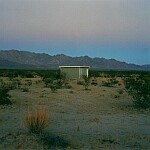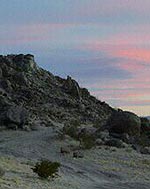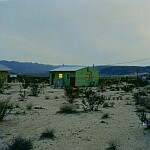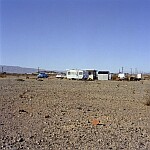| |
eyestorm: How did the 'Isolated House' series come about?
John Divola: I had been working with iconographies of the sublime, exhausted iconographies: in the early 90s I made the 'Four Landscapes' series, grainy black and white photographs of people looking to be outside culture. The four landscapes were the four ecologies of Southern California: mountains, desert, city, sea. And the photos showed evidence of people wandering off into nature or building houses in the desert. That was the genesis of the 'Isolated House' work, looking at this ironic, literal desire to step outside of culture. But when I was out there in the landscape I was just struck by its beauty - the lighting, the infinite plane of the desert - so I went back to it in a more visually indulgent manner.
How do you think the photographs' seductiveness works within their conceptual framework?
Well, in all my work there's this notion of the melancholic. You can make a photograph about the sublime, but you can't make the sublime itself - you can never make the equivalent of lying in a quarry at midnight, looking at the moon. You can talk about it, sure, but you always end up with this dead, industrial thing, which is about a visceral, biological, human reaction. Beauty is part of the language of that. I want them to be seductive, but they're also about an unattainable desire. Yet the work is ultimately not meant to articulate a single point; there could be a range of accents to it.
What makes a particular image resonate for you?
I shoot quite a bit, intuitively, and I'm looking for a combination of things. There's the formal aspect of this 'cube on the landscape', and the artificial colors that people paint their houses in relation to natural colors. And things that express a minimum, generic notion of habitation, reducing the notion of 'house' right down - some of these places are like houses on a Monopoly board. I'm also interested in isolation, and - finally - in what I don't expect. The concept aside, it's an experiential process. I loved doing that project, moving through that landscape, coming upon things and making evaluations.
Did you meet any of the people living in those houses?
Yeah, my car broke down a couple of times and I had to knock on doors. I had some very strange encounters. The people were all very nice, although some would chase me, wondering why I was taking photographs. People are out in that landscape either because they have this desire to be away, or they've been pushed - either socio-economically or because they can't fit in. You have a very interesting mix of people who are right on the edge, paranoid people. One had built a compound. Another place, my car broke down and I went to a house, the windows were full of lace and knick-knacks. I was expecting some old lady, but two bare-chested guys came to the door and they were on some kind of opiate, moving very, very slowly. This was mid-afternoon. They turned out to be nice people.
|



